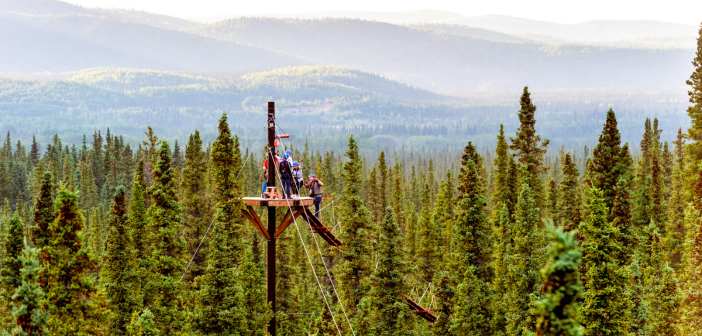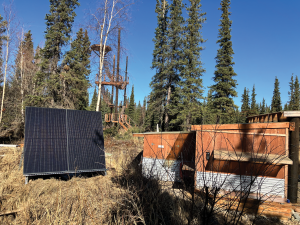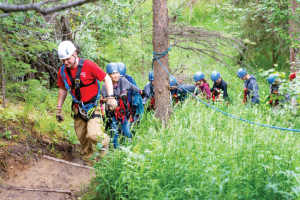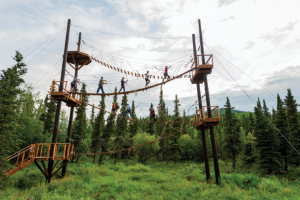“We choose to go to the moon and do other things, not because they are easy, but because they are hard,” President John F. Kennedy famously said in 1962. That sentiment might fairly apply to living in backcountry Alaska in general and operating a zip line tour there in particular.
When the Davis family decided to create Denali Park Zipline in 2015, the hardness of the project was of Alaskan proportions. They had chosen a location, at the edge of Denali National Park and more or less out in the middle of nowhere, accessible only via a 3-mile, boulder-strewn road resembling a dry riverbed. The zip-line-tour-to-be would be off the grid—no public electricity.
The characteristic constituents of the boreal environment—spongy tundra, stunted tree growth, permafrost—were not conducive to standard zip line construction methodology. The operating season would be little more than three months long, a sliver of a revenue-producing window that would be particularly small considering that the capacity of the planned tour would be just 10 people at a time. Finding and retaining qualified staff for such a short season in such a remote location would be daunting. And so on. It wouldn’t be easy; it would be hard. But the Davises, following Kennedy’s lead, chose to do it.
They did, however, have some idea of what they were getting into. They already had a track record of running successful tourism businesses in the area, having started with ATV tours in 2007 and later expanding to Jeep tours as well. When a 60-acre plot of land became available near the national-park entrance and surrounded by the park on three sides, they saw an opportunity, and they jumped.
Building in Boreal Forest
The first order of business was to contract a zip line construction company. The Davises chose Synergo, based in Portland, Ore. The company seemed a good fit for the assignment, touting a building philosophy of creating courses that are “challenging, aesthetically pleasing and harmonious with the natural environment.”
Construction. With the ground not fully releasing the winter frost until midsummer, the onset of construction had to wait until July. Things then moved along at a less-than-speedy pace, with the construction timeframe extending to three months at least in part because of the difficulty in getting building materials on site.
Big stuff—the poles, cables, construction lumber, etc.—had to be barged in to the coast from afar and then trucked inland on a long drive of several hours. The trip was only complete after a scramble up that riverbed-like access road, with the poles being dragged behind an excavator. Even for something small and simple, say, a box of screws, the nearest hardware store was in Fairbanks, a two-hour drive away.
The land is what general manager Colin Henderson calls “a mix of tundra and taiga (boreal forest),” and trees in the slow-growth zone of that subarctic climate were too small to provide structural support for zip lines and platforms. So, the entire tour—eight zip lines connected by six sky bridges and a ladder—had to be built with poles. Fortunately, most of the subsurface was rocky and stable for reliable anchoring, although Henderson says that two poles had to be set on tundral underpinnings and still require vigilant oversight to be sure they haven’t shifted.
Regulation. One aspect of the project that proved to be not especially hard was getting regulatory approval. One might think that in the pristine Alaskan wilderness, environmental regulations would be fairly stringent, especially on the periphery of a national park. But according to Henderson, because the zip line wouldn’t be impacting any salmon spawning streams—a big environmental issue in Alaska—there were few regulatory hurdles to clear.
Cost. The other good news: start-up costs were relatively modest.
When all added up— the construction cost of the zip line tour and other infrastructure such as outbuildings, and the purchase of a fleet of side-by-side UTVs to shuttle people up and down the access road as well as a fleet of vans to get people from nearby lodging to the site—the total investment was less than $1 million.
The bottom-line cost was minimized by keeping the job of building the supporting infrastructure in-house as much as possible. While a Synergo crew was responsible for the construction of the zip line itself, Henderson took charge of overseeing the construction of other outbuildings for storage and the like. (The main tour administrative office is in the nearby town of Healy.) Another cost-saver was the decision not to smooth out or pave the access road, which would have been an expensive undertaking. It was determined that the rough-and-tumble ride could actually be an asset; “it makes you feel like you’re really in the bush,” says Henderson.
Operations Considerations
Once up and running the next summer, the next challenge was to get people to come. According to Henderson, there are only about 450,000 visitors annually to Denali National Park (it drew around 600,000 visitors per year from 2016-2019, and is on the upswing post-Covid), compared with, say, the more than 14 million annual visitors to Great Smoky Mountains National Park, where nearby adventure and theme parks flourish.
Accommodations near the park entrance are limited. What Henderson calls “local traffic”—from Fairbanks, to the north, or Anchorage, a drive of four hours or more to the south—could be counted on for only about 5 percent of all customers.
However, Alaska is a popular haven (literally) for cruise ships, and Denali Park Zipline partnered with cruise-ship and other tour operators to generate about 30 percent of its business from those sources. After that, park visitors staying in local lodging, RV travelers, and “lots of groups”—mostly scouts and military personnel—fill out the guest list.
Revenue generators. Because the park relies on solar for its electricity, ancillary revenue opportunities were limited. Food and beverage, for example, was out of the question. Some merchandise items, i.e., t-shirts, are in the mix, but they represent a small piece of the revenue pie. The tour itself stands largely alone as a revenue generator, priced at $159 per adult and $119 for kids 8 to 12 years old, transportation included, for a three-hour tour from pick-up to drop-off. (Group discounts are also available.)
With the tour now attracting about 6,000 customers a year, there is enough money coming in to turn a profit. The initial capital investment was covered within five years, says Henderson.
Skilled staff. For all the challenges that backcountry Alaska presents, “the hardest part of the job is staffing,” says Henderson. But, he adds, “it is also the most important part of the job.” Perhaps more than many zip tour operators, he tasks his guides with a high degree of responsibility.
“Guides do everything,” he says, meaning “they perform all course positions and duties except for higher-level tasks like periodic inspections or critical incident reviews. More importantly, they learn a comprehensive skill set of rescues, including platform lowering, rappelling, rappel self-rescue, trolly swaps, mid-cable cutaways, lanyard fall rescues, bridge rescues, and mass evacuations for environmental emergencies.” Guides are also empowered to cancel tours if the weather is outside of established safety protocols.
It is essential that all the guides are trained in the same skills and self-sufficient, says Henderson, as emergency medical services can take up to an hour to arrive and he can’t be on site at all times. “Murphy’s law says that emergencies will happen when I am away.”
Recruiting. One tactic Henderson uses in recruiting staff is to post job listings on online job board Cool Works. Denali Park Zipline also shares with the Davises’ vehicle-excursion adventures a staff-recruitment site, workindenali.com. However, getting the quality of employee he is looking for to fill out a staff of about 25 (16 of whom are actually running the zip line) is no small task when relying largely on inexperienced young people looking for summer jobs. And once he has his staff assembled, training is arduous—at least 80 hours in often harsh, late-spring weather. These are not jobs that just any warm body can fill.
However, Henderson says that because the zip line relies so heavily on the performance of its guides, in return he goes out of his way to make sure that they are treated well. Employee housing with private rooms is provided nearby. A fleet of employee cars to commute to and from the zip line site is made available. Good performance is rewarded with end-of-season bonuses. And in general, Henderson tries to nurture a high degree of respect, appreciation, and worker morale for the effort his staff puts in.
The result, at least pre-Covid, was a surprisingly high annual rate of return employees, given the location and the short season—somewhere around 50 percent. Covid threw a large wrench into the staffing works, as it did in many places, but Henderson says that the tour is now scrambling its way back toward a healthy return rate.
Stamp of Approval
Whatever Denali Park Zipline is doing, it seems to be working, and it now has ACCT accreditation to validate that fact. This year, the zip line tour was given the ACCT’s stamp of approval with an Operation Accreditation, earned after what Henderson calls “a mountain of paperwork” and rigorous inspection.
Many parks that apply for such recognition prepare ahead of time for the inspection to be sure everything is running smoothly, safely, and professionally. But Henderson says that he essentially did nothing—if the park was to earn its accreditation, it ought to be based on regular day-to-day operations, not on some dolled-up, inspector-pleasing version. Earning a thumbs-up under those circumstances, says Henderson, was strong affirmation that what Denali was doing was right.
But why go through the process at all? Henderson admits that there was at least some ego involved in being able to bask in the distinction of being a certifiably well-run operation. He compares the ACCT accreditation to the Michelin stars that first-rate restaurants crave. However, because the meaning of the accreditation (unlike Michelin stars) might not yet be appreciated by the majority of visitors, the marketing value for the time being is probably minimal.
Yet there was one immediate and substantial reward: Henderson says the park saw a drop of $40,000 in its insurance costs. He also sees the possibility of a bigger-picture, long-term benefit. He believes that if he can convince other aerial-adventure operators in the state to go through the accreditation process, it could help to elevate the Alaska brand as home to the best-run aerial adventures in the country. He admits that that might be a pipe dream, but he sees it as something out of the rising-tide-lifts-all-boats playbook.
Rugged appeal. Henderson speculates that Denali Park Zipline is the northernmost zip line in North America. That might be true and it might be a selling point, but it is also an assurance that nothing, from construction, to operations, to staffing, comes easy. Yet that’s a fundamental allure of living in or visiting Alaska. It’s a place where you go not because it is easy but because it is hard










